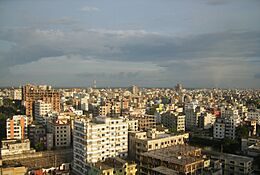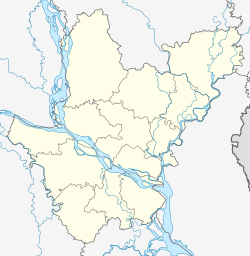Narayanganj facts for kids
Quick facts for kids
Narayanganj
নারায়ণগঞ্জ
|
|
|---|---|
|
From top: City Skyline, Port of Narayanganj,
Tomb of Sultan Ghiyasuddin Azam Shah , Baro-Bhuyan Palace of Lord Isa Khan, Historical Panam City, Hajiganj Fort in City East |
|
| Country | |
| Division | Dhaka |
| District | Narayanganj |
| Municipal Board | 8 September 1876 |
| Metropolitan city | 5 May 2011 |
| Government | |
| • Type | Mayor–council government |
| • Body | Narayanganj City Corporation |
| Area | |
| • Metropolis | 33.57 km2 (12.96 sq mi) |
| • Water | 48.56 km2 (18.75 sq mi) |
| • Metro | 72.43 km2 (27.97 sq mi) |
| Elevation | 3 m (10 ft) |
| Population
(2022)
|
|
| • Metropolis | 967,951 |
| • Density | 28,834/km2 (74,679/sq mi) |
| Time zone | UTC+6 (Bangladesh Time) |
| Postal code |
1420
|
| Area code(s) | 0671 |
| Calling Code | 02 |
Narayanganj (Bengali: নারায়ণগঞ্জ, romanized: Naraeongônj) is a city in central Bangladesh in the Greater Dhaka area. It is in the Narayanganj District, about 16 km (10 mi) southeast of the capital city of Dhaka. With a population of almost 1 million, it is the 6th largest city in Bangladesh. It is also a center of business and industry, especially the jute trade and processing plants, and the textile sector of the country. It is nicknamed the Dundee of Bangladesh, due to the presence of its many jute mills. (Dundee was the first industrialised 'Juteopolis' in the world.)
Contents
History
The city got its name from Bicon Lal Pandey, a Hindu religious leader who was also known as Benur Thakur or 'Lakshmi Narayan Thakur'. He leased the area from the British East India Company in 1766 following the Battle of Plassey. He donated the markets and the land on the banks of the river as Devottor or 'Given to God' property, bequeathed for maintenance expenses for the worship of the god Narayan.
A post office was set up in 1866, and Dhaka-Narayanganj telegraph service was started in 1877. The Bank of Bengal introduced the first telephone service in 1882.
The Narayanganj Municipality was incorporated on 8 September 1876. The first hospital in the area of Narayanganj Victoria Hospital was established in 1885 by the Municipality with financial contributions from Harakanta Banerjee.
Narayanganj City Corporation was established on 5 May 2011, unifying three former municipalities: Narayanganj Municipality, Siddhirganj Municipality, and Kadam Rasul Municipality. The mayor of Narayanganj City Corporation (NCC) is Selina Hayat Ivy. Prior to this, she was the mayor of Narayanganj Municipality.
Demographics
| Religions in Narayanganj City Corporation (2011) | ||||
|---|---|---|---|---|
| Religion | Percent | |||
| Islam | 91.22% | |||
| Hinduism | 8.71% | |||
| Other or not stated | 0.07% | |||
According to the 2011 Bangladesh census, present-day Narayanganj City Corporation had 165,637 households and a population of 709,381. 138,130 (19.47%) were under 10 years of age. Narayanganj had a literacy rate (age 7 and over) of 66.37%, compared to the national average of 51.8%, and a sex ratio of 943 females per 1000 males. In 2022, the population of Narayanganj City Corporation was 967,951.
Transport
Narayanganj has two railway stations named Chashara railway station and Narayanganj railway station. From Dhaka anyone can use three roads to enter the city: Dhaka–Narayanganj old road, Dhaka–Narayanganj link road and Narayanganj–Demra road. The BRTC AC Bus gives bus transport service from Narayanganj to Dhaka.
See also
 In Spanish: Narayanganj para niños
In Spanish: Narayanganj para niños










